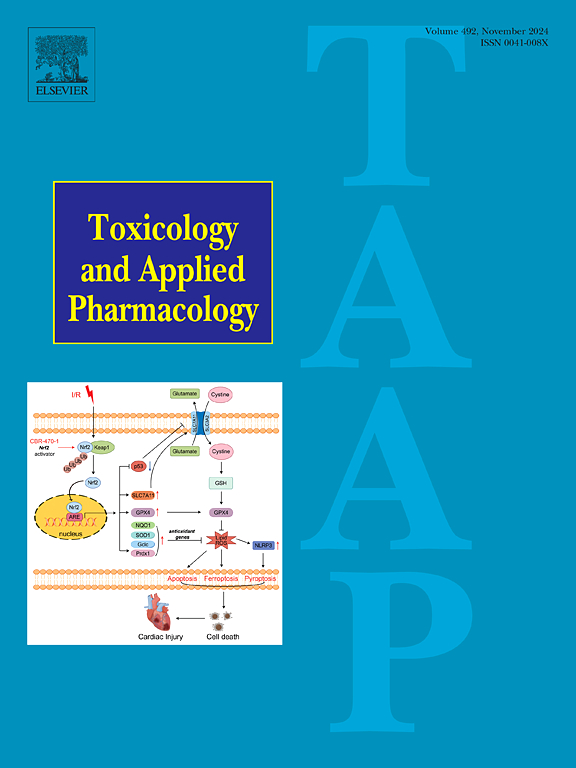褪黑素对5-氟尿嘧啶诱导的大鼠心脏毒性的保护作用:氧化、炎症和凋亡途径的综合评估
IF 3.3
3区 医学
Q2 PHARMACOLOGY & PHARMACY
引用次数: 0
摘要
背景:心脏毒性是5-氟尿嘧啶(5-FU)一种常见的化疗药物的严重不良反应。本研究旨在评估褪黑素(MLT)对5-氟尿嘧啶(5-FU)诱导的大鼠心脏毒性的保护作用,重点关注氧化应激、炎症途径、基因表达、心电图和组织病理学变化。材料与方法雄性Wistar大鼠25只,随机分为5组。动物接受剂量为2.5、5或10 mg/kg/天的MLT,剂量为50 mg/kg (i.p)的5- fu,或两种治疗的组合。通过心电图、心肌酶、氧化应激标志物和组织病理学评估心脏毒性。结果5- fu治疗可显著增加氧化应激标志物和炎症介质,同时引起心脏组织病理损伤。通过降低丙二醛(MDA)、一氧化氮(NO)和髓过氧化物酶(MPO)的水平,MLT与5-FU的联合使用显著减轻了这些影响,从而减少了氧化损伤。此外,MLT增强了抗氧化活性,这可以通过增加心脏组织中超氧化物歧化酶(SOD)和谷胱甘肽过氧化物酶(GPx)的水平来反映。基因表达分析进一步证实,MLT治疗降低了COX-2和VEGF的升高水平,而COX-2和VEGF是炎症过程中的关键参与者。组织病理学检查表明,MLT保持了心肌组织的结构完整性,并以剂量依赖的方式降低了5- fu诱导的损伤评分。此外,MLT联合给药显著降低了与5- fu诱导的心脏毒性相关的LDH、AST和CK-MB等心脏生物标志物的升高。结论MLT通过其抗氧化和抗炎作用,对5- fu诱导的毒性具有保护作用,提示其在化疗期间改善心血管健康的治疗潜力。本文章由计算机程序翻译,如有差异,请以英文原文为准。

Protective effects of melatonin against 5-fluorouracil-induced cardiotoxicity in rats: A comprehensive evaluation of oxidative, inflammatory, and apoptotic pathways
Background
Cardiotoxicity is a serious adverse effect of 5-fluorouracil (5-FU) a common chemotherapeutic agent. This study aimed to evaluate the protective effects of melatonin (MLT) against 5-fluorouracil (5-FU)-induced cardiotoxicity in rats, focusing on oxidative stress, inflammatory pathways, gene expression, electrocardiographic and histopathological changes.
Materials and methods
Twenty-five male Wistar rats were divided into five groups. The animals received either MLT at doses of 2.5, 5, or 10 mg/kg/day, 5-FU at 50 mg/kg (i.p.), or a combination of both treatments. Cardiotoxicity was assessed through electrocardiography, cardiac enzymes, oxidative stress markers, and histopathology.
Results
5-FU treatment significantly increased oxidative stress markers and inflammatory mediators while causing histopathological damage in heart tissues. Co-administration of MLT with 5-FU significantly mitigated these effects by reducing oxidative damage, as evidenced by lower levels of malondialdehyde (MDA), nitric oxide (NO), and myeloperoxidase (MPO). Additionally, MLT enhanced antioxidant activity, as reflected by increased levels of superoxide dismutase (SOD) and glutathione peroxidase (GPx) in heart tissues. Gene expression analysis further confirmed that MLT treatment reduced the elevated levels of COX-2 and VEGF, which are critical players in the inflammatory process. Histopathological examination demonstrated that MLT preserved the structural integrity of myocardial tissues, reducing 5-FU-induced damage score in a dose-dependent manner. Furthermore, MLT co-administration significantly attenuated the rise in cardiac biomarkers, including LDH, AST, and CK-MB, associated with 5-FU-induced cardiotoxicity.
Conclusion
These findings highlight that MLT, through its antioxidant and anti-inflammatory properties, exerts a protective effect against 5-FU-induced toxicity, suggesting its therapeutic potential for improving cardiovascular health during chemotherapy.
求助全文
通过发布文献求助,成功后即可免费获取论文全文。
去求助
来源期刊
CiteScore
6.80
自引率
2.60%
发文量
309
审稿时长
32 days
期刊介绍:
Toxicology and Applied Pharmacology publishes original scientific research of relevance to animals or humans pertaining to the action of chemicals, drugs, or chemically-defined natural products.
Regular articles address mechanistic approaches to physiological, pharmacologic, biochemical, cellular, or molecular understanding of toxicologic/pathologic lesions and to methods used to describe these responses. Safety Science articles address outstanding state-of-the-art preclinical and human translational characterization of drug and chemical safety employing cutting-edge science. Highly significant Regulatory Safety Science articles will also be considered in this category. Papers concerned with alternatives to the use of experimental animals are encouraged.
Short articles report on high impact studies of broad interest to readers of TAAP that would benefit from rapid publication. These articles should contain no more than a combined total of four figures and tables. Authors should include in their cover letter the justification for consideration of their manuscript as a short article.

 求助内容:
求助内容: 应助结果提醒方式:
应助结果提醒方式:


